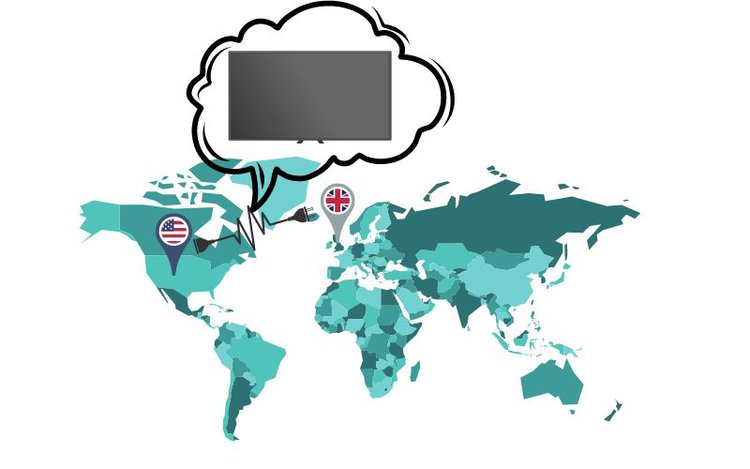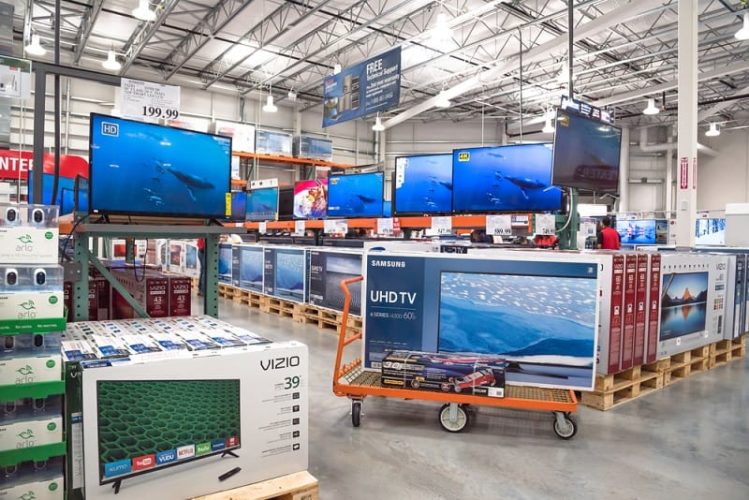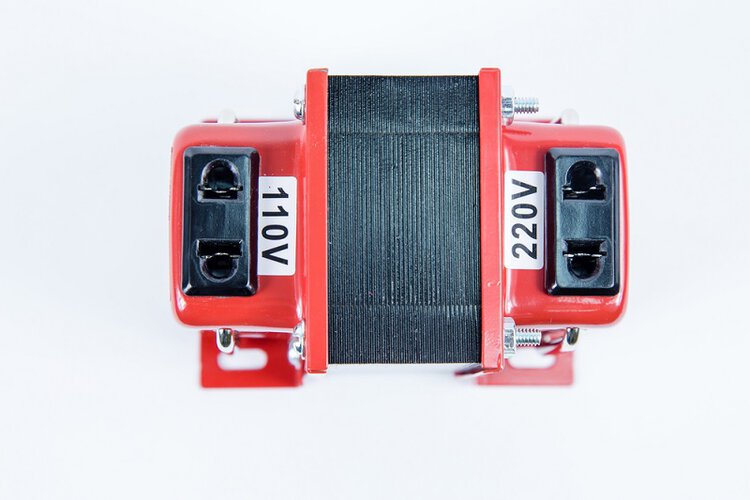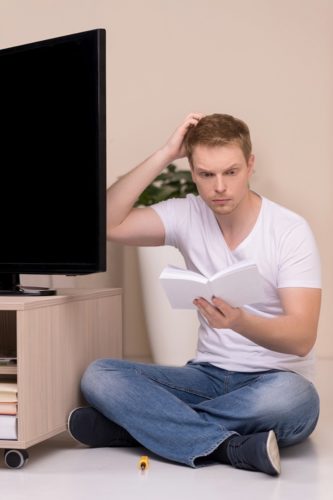How to Use US TVs in the UK? Voltage System Explained

What To Know
- US TVs require 110-120 Volts and are not natively compatible with the UK’s 220-230 Volt system, posing risks like short circuits or fire hazards.
- To use a US TV in the UK, a step-down transformer is needed to match the TV’s voltage requirements with the UK’s higher voltage outlets.
- Some TVs are dual voltage, capable of working with both 110V and 220V systems, and this can be verified through the TV’s manual or internal labels.
In this article, we’ll explore if your US TV is dual voltage and how it can work in the UK’s voltage system.
Let’s get started!
Quick Navigation
Do US TVs Work in the UK?

No, US TVs will not natively work in the UK.
US TVs require between 110 to 120 Volts to function. On the other hand, UK wall outlets emit between 220 to 230 Volts.
Because the TV’s voltage requirement is lower than the amount of power supplied by the wall outlet, you risk your TV blowing a fuse in your home. Additionally, it could cause the TV and/or outlet to smoke or cause a short circuit.
In the worst-case scenario, your TV and outlet could pose a fire hazard.
This isn’t only the case for American TVs, as other American appliances may pose fire hazards when plugged directly into UK outlets.
Luckily, there is a solution.
How To Use A TV from the US in the UK (110V to 220V)?

To use an American TV with a UK wall outlet, you will need to invest in a step-down transformer. This transformer will decrease the wall outlet’s output, allowing you to safely plug an American TV into it.
Step 1: Before you can start using a step-down transformer, you need to find your TV’s wattage rate. While most TVs don’t exceed 200 Watts, it’s important to double-check to ensure it’s compatible with the transformer.
You can usually find your TV’s wattage on the back of the unit, on its original packaging, or in the user manual.
Step 2: Once you’ve confirmed your TV’s wattage, it’s time to buy a step-down transformer.
We recommend the ELC 1000W Step Up/Down Transformer or SEYAS 1000W Step Up/Down Transformer , both of which are available online.
- Up to 1000-Watt Maximum Capacity (Step Up/Down)- Voltage Converter transformer. Heavy Duty Step...
- Please note: This converter is designed only for European/Asian 220V (Single Phase), it will not...
- This transformer device makes no noise while in use, a completely silent and easy to use and it does...
Last update on 2025-05-30 / Paid Link.
Even if your TV’s wattage is below 200W, we still recommend investing in a transformer with a larger capacity. This will accommodate any power surges or fluctuations that may occur from faulty wiring or severe weather conditions. It will also protect your TV’s wiring from any unfortunate electrical mishaps.
The linked transformers function as both step-down and step-up transformers, and are compatible with 110V to 220V setups, as well as 220V to 110V setups.
If you travel a lot, this is the perfect gadget to have in your toolbox.
Step 3: Connect the transformer to a 220V UK wall outlet. Then turn it on by flipping the transformer’s power switch.
Step 4: Next, plug your 110V TV’s power cable into the transformer’s 110V outlet.
Step 5: Finally, turn your TV on and see if it’s working normally.
If anything seems wrong (e.g. strange noises, smoke, etc.), immediately turn off the TV and transformer. Then, unplug the transformer from the wall before unplugging the TV from it.
Different AC Voltage Across Different Countries
The United States and the United Kingdom have different AC voltages. This term describes how much power each country’s electrical outlets emit.
An outlet’s AC voltage is directly related to that country’s appliances’ electrical charges, as they must be able to be powered by the wall outlets.
While the US uses 110 to 120 Volts of power, the UK uses between 220 to 230 Volts.
If you’re planning on moving to another country and need to know its AC voltage standard, check out the List of Voltages & Frequencies (Hz) Around the World.
Dual Voltage TVs
Some TVs are dual voltage, meaning they can be connected with both 110V and 220V wall outlets. They can do this because of their built-in power converter, which allows them to be plugged into any compatible wall outlet without a step-down or step-up transformer.
However, only select TV models from a handful of manufacturers are dual voltage. If you’re interested in finding a dual voltage TV or want to know if your TV is dual voltage, consult this list of dual voltage TVs.
How to Know If Your TV is Dual Voltage?
There are a few different ways you can find out if your TV is dual voltage.
The first way is to consult the user manual. If you’ve lost the original user manual that came in your TV’s packaging, you can search for a searchable PDF version of the manual online.

In the user manual, check if there’s a section reading 100-240V, 110V, 220V, or 100-240Vac. This will confirm if your TV is dual voltage or worldwide voltage.
The second way to tell if your TV is dual voltage is by removing the TV’s back panel using a small Philips screwdriver. You will need to lay your TV screen side down on a flat, soft surface to do this.
So, lay a thick towel or blanket on the ground before carefully removing your TV from its entertainment stand or wall mount. Don’t forget to unplug everything from it before doing this to avoid yanking the TV’s cables out of their ports.
On the inside of the TV’s back panel, look for labels that say 100-240V, 110V and 220V, or 100-240Vac.
If you’re having trouble accessing your TV’s specs, consider contacting the TV’s customer support. Provide them with your TV’s model number and inquire if your unit is dual voltage.
For your convenience, we’ve linked the contact information for Samsung, LG, and Sony.
To learn more about dual-voltage appliances, how they work, and how to tell if your TV is one of them, watch the video below.
Does Using a Foreign Antenna Still Receive Local Channels?
Yes, you should be able to access local UK channels with a US antenna.
While US and UK antennae are manufactured differently, the US and UK’s signal frequencies overlap. This means that your US antenna will be able to access and display UK channels with ease.
So, as long as your US TV is set up correctly and safely in your new home in the UK, you should have no problem watching all of your favorite UK channels with your compatible antenna.
US vs UK Frequencies
| VHF | UHF | |
| US | 44.31 – 215.75 Mhz | 470-890 Mhz |
| UK | 41.5 – 214.75 Mhz | 470 – 860 Mhz |
Just make sure that your antenna is set up correctly so that it can detect the signals. This process takes a little skill and patience.
Watch the video tutorial below to learn how to set up a TV antenna to receive the best reception possible.
Yesenia Achlim is a technical copywriter and editor with a focus on AV equipment. She aims to break down complicated topics and make technology accessible, no matter your technical expertise. When she’s not teaching you how to replace a projector lamp, you can find her reading and baking.


